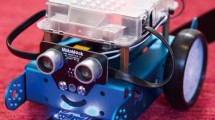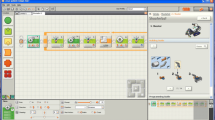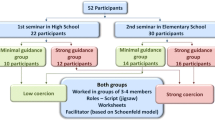Abstract
Currently, the cognitive load imposed by tasks with different complexity during collaborative learning or pair learning has not been well studied. This study examined the effect of three types of tasks with different complexity on students’ cognitive load during pair learning. We randomly selected a total of 76 pupils to participate in a one-semester robotics course for the experiment. The results showed that the difference in students’ cognitive load imposed by pair learning and robotics tasks with different complexity was not significant. However, it is complicated to explain the results. From one side of the coin, pair learning may be a key factor. The more complex the task is, the more possible that an individuals would collaborate with partners to promote the equal allocation of intrinsic cognitive load. In contrast, the simple tasks would cause free-riding and thus impede the equal allocation of cognitive load. From another side, the essence of germane cognitive load might play an important role too, since students’ schemas were not sufficiently automated when they encountered the easy tasks at the early learning stage, but automated to some extent when they complete complex tasks during the later learning period. Implications for practitioners are also discussed in this study.

Similar content being viewed by others
References
Xia L, Zhong B (2018) A systematic review on teaching and learning robotics content knowledge in K-12. Comput Educ 127:267–282
Benitti FBV (2012) Exploring the educational potential of robotics in schools: a systematic review. Comput Educ 58(3):978–988
Sisman B, Kucuk S, Yaman Y (2020) The effects of robotics training on children’s spatial ability and attitude toward STEM. Int J Soc Robot. https://doi.org/10.1007/s12369-020-00646-9
Cheng CC, Huang PL, Huang KH (2013) Cooperative learning in LEGO robotics projects: exploring the impacts of group formation on interaction and achievement. J Netw 8(7):1529–1535
Jung S (2013) Experiences in developing an experimental robotics course program for undergraduate education. IEEE Trans Educ 56(1):129–136
Hwang WY, Wu SY (2014) A case study of collaboration with multi-robots and its effect on children’s interaction. Interact Learn Environ 22(4):429–443
Jordan ME, JrRR McDaniel (2014) Managing uncertainty during collaborative problem solving in elementary school teams: the role of peer influence in robotics engineering activity. J Learn Sci 23(4):490–536
Liu EZF, Lin CH, Chang CS (2010) Student satisfaction and self-efficacy in a cooperative robotics course. Soc Behav Personal 38(8):1135–1146
Menekse M, Higashi R, Schunn CD, Baehr E (2017) The role of robotics teams’ collaboration quality on team performance in a robotics tournament. J Eng Educ 106(4):564–584
Chandra S, Alves-Oliveira P, Lemaignan S, Sequeira P, Paiva A, Dillenbourg P (2016) Children's peer assessment and self-disclosure in the presence of an educational robot. In: Proceedings of the 25th IEEE international symposium on robot and human interactive communication (RO-MAN), pp 539–544. https://doi.org/10.1109/ROMAN.2016.7745170
Kanda T, Hirano T, Eaton D, Ishiguro H (2004) Interactive robots as social partners and peer tutors for children: a field trial. Hum Comput Interact 19(1):61–84
Chen H, Park HW, Breazeal C (2020) Teaching and learning with children: impact of reciprocal peer learning with a social robot on children’s learning and emotive engagement. Comput Educ 150:103836
Correll N, Rus D (2010) Peer-to-peer learning in robotics education: lessons from a challenge project class. Comput Educ J 1(3):60–66
Williams LA, Kessler RR (2000) All I really need to know about pair programming I learned in kindergarten. Commun ACM 43(5):108–114
Zhong B, Li T (2020) Can pair learning improve students’ troubleshooting performance in robotics education? J Educ Comput Res 58(1):220–248
Kirschner F, Paas F, Kirschner PA (2009) A cognitive load approach to collaborative learning: united brains for complex tasks. Educ Psychol Rev 21:31–42
Kirschner F, Paas F, Kirschner PA (2009) Effects of individual and group-based learning from complex cognitive tasks on efficiency of retention and transfer performance. Comput Hum Behav 25:306–314
Kirschner F, Paas F, Kirschner PA, Janssen J (2011) Differential effects of problem-solving demands on individual and collaborative learning outcomes. Learn Instr 21(4):587–599
Kirschner F, Paas F, Kirschner PA (2011) Task complexity as a driver for collaborative learning efficiency: the collective working-memory effect. Appl Cogn Psychol 25(4):615–624
Ayres P (2006) Using subjective measures to detect variations of intrinsic cognitive load within problems. Learn Instr 16(5):389–400
Haji FA, Rojas D, Childs R, de Ribaupierre S, Dubrowski A (2015) Measuring cognitive load: performance, mental effort and simulation task complexity. Med Educ 49(8):815–827
Sweller J (2010) Element interactivity and intrinsic, extraneous, and germane cognitive load. Educ Psychol Rev 22(2):123–138
Kirschner PA, Sweller J, Kirschner F, Zambroano RJ (2018) From cognitive load theory to collaborative cognitive load theory. Int J Comput Supp Coll 13(2):213–233
Clark RC, Nguyen F, Sweller J (2005) Efficiency in learning: evidence-based guidelines to manage cognitive load. Pfeiffer, San Francisco
Leppink J, Paas F, van Gog T, van der Vleuten CPM, van Merriënboer JJG (2014) Effects of pairs of problems and examples on task performance and different types of cognitive load. Learn Instr 30:32–42
Korbach A, Brünken R, Park B (2018) Differentiating different types of cognitive load: a comparison of different measures. Educ Psychol Rev 30(2):503–529
Paas F, Tuovinen JE, Tabbers H, Van Gerven PW (2003) Cognitive load measurement as a means to advance cognitive load theory. Educ Psychol 38(1):63–71
Paas FG (1992) Training strategies for attaining transfer of problem-solving skill in statistics: a cognitive-load approach. J Educ Psychol 84(4):429–434
Paas FG, Van Merriënboer JJ, Adam JJ (1994) Measurement of cognitive load in instructional research. Percept Mot Skills 79(1):419–430
Retnowati E, Ayres P, Sweller J (2018) Collaborative learning effects when students have complete or incomplete knowledge. Appl Cogn Psychol 32(6):681–692
Hannay JE, Arisholm E, Engvik H, Sjøberg DI (2010) Effects of personality on pair programming. IEEE Trans Softw Eng 36(1):61–80
van Gog T, Paas F, van Merriënboer JJG (2006) Effects of process-oriented worked examples on troubleshooting transfer performance. Learn Instr 16(2):154–164
Campbell DJ (1988) Task complexity: a review and analysis. Acad Manag Rev 13(1):40–52
Zhong B, Wang Q, Chen J, Li Y (2016) An exploration of three-dimensional integrated assessment for computational thinking. J Educ Comput Res 53(4):562–590
Barak M, Assal M (2018) Robotics and STEM learning: Students’ achievements in assignments according to the P3 Task Taxonomy—practice, problem solving, and projects. Int J Technol Des Ed 28(1):121–144
Puurtinen M, Mappes T (2009) Between-group competition and human cooperation. Proc R Soc Lond B Biol Sci 276(1655):355–360
McDowell C, Werner L, Bullock H, Fernald J (2006) Pair programming improves student retention, confidence, and program quality. Commun ACM 49(8):90–95
Shanks D, Brydges R, Den Brok W, Nair P, Hatala R (2013) Are two heads better than one? Comparing dyad and self-regulated learning in simulation training. Med Educ 47(12):1215–1222
Zhong B, Wang Q, Chen J, Li Y (2017) Investigating the period of switching roles in pair programming in a primary school. Educ Technol Soc 20(3):211–224
Di Lieto MC, Inguaggiato E, Castro E, Cecchi F, Cioni G, Dell’Omo M, Laschi C, Pecini C, Santerini G, Sgandurra G, Dario P (2017) Educational robotics intervention on executive functions in preschool children: a pilot study. Comput Hum Behav 71:16–23
Hinsz VB, Tindale RS, Vollrath DA (1997) The emerging conceptualization of groups as information processors. Psychol Bull 121:43–64
Tolsgaard MG, Kulasegaram KM, Ringsted CV (2016) Collaborative learning of clinical skills in health professions education: the why, how, when and for whom. Med Educ 50(1):69–78
Janssen J, Kirschner F, Erkens G, Kirschner PA, Paas F (2010) Making the black box of collaborative learning transparent: combining process-oriented and cognitive lead approaches. Educ Psychol Rev 22(2):139–154
Sevenhuysen S, Farlie MK, Keating JL, Haines TP, Molloy E (2015) Physiotherapy students and clinical educators perceive several ways in which incorporating peer-assisted learning could improve clinical placements: a qualitative study. J Physiother 61(2):87–92
Bodemer D, Dehler J (2011) Group awareness in CSCL environments. Comput Hum Behav 27(3):1043–1045
Gutwin C, Greenberg S (2004) The importance of awareness for team cognition in distributed collaboration. In: Salas E, Fiore SM (eds) Team cognition: understanding the factors that drive process and performance. APA Press, Washington, DC, pp 177–201
Zhong B, Zheng J, Zhan Z (2020) An exploration of combining virtual and physical robots in robotics education. Interact Learn Environ. https://doi.org/10.1080/10494820.2020.1786409
Katira N, Williams L, Wiebe E, Miller C, Balik S, Gehringer E (2004) On understanding compatibility of student pair programmers. ACM SIGCSE Bull 36(1):7e11
Zhong B, Wang Q, Chen J (2016) The impact of social factors on pair programming in a primary school. Comput Hum Behav 64:423–431
Fontenot M, Canales K, Quicksall AN (2014) Taking care of the team in a first-year design experience course. In: Proceedings of the 2014 conference of frontiers in education. IEEE, New York, pp 1–5
Okita SY (2014) The relative merits of transparency: investigating situations that support the use of robotics in developing student learning adaptability across virtual and physical computing platforms. Brit J Educ Technol 45(5):844–862
Bianco AS (2014) Starting and teaching: basic robotics in the classroom: modern, engaging engineering in technology education. Technol Eng Teach 73(7):32–38
Janssen J, Erkens G, Kirschner PA (2011) Group awareness tools: it’s what you do with it that matters. Comput Hum Behav 27(3):1046–1058
Jermann P, Dillenbourg P (2008) Group mirrors to support interaction regulation in collaborative problem solving. Comput Educ 51(1):279–296
Sweller J (2004) Instructional design consequences of an analogy between evolution by natural selection and human cognitive architecture. Instr Sci 32:9–31
Sweller J, Sweller S (2006) Natural information processing systems. Evol Psychol 4:434–458
Su H, Yang C, Ferrigno G, De Momi E (2019) Improved human–robot collaborative control of redundant robot for teleoperated minimally invasive surgery. IEEE Robot Autom Lett 4(2):1447–1453
Su H, Hu Y, Karimi HR, Knoll A, Momi ED (2020) Improved recurrent neural network-based manipulator control with remote center of motion constraints: experimental results. Neural Netw 131:291–299
Acknowledgements
The authors would like to thank Liying Xia, Qiuju Si, and Zehui Zhan for checking this manuscript, and deeply grateful to the anonymous reviewers and editors for their constructive and insightful feedback on this manuscript.
Funding
This study is funded by the General Project for Education from National Social Science Fund of China (Study on Pair Learning Model in Robotics Education in K-12, Grant No. BCA190088).
Author information
Authors and Affiliations
Corresponding author
Ethics declarations
Conflict of interest
The authors declare that they have no conflict of interest.
Rights and permissions
About this article
Cite this article
Zhong, B., Wang, J. Exploring the Non-significant Difference on Students’ Cognitive Load Imposed by Robotics Tasks in Pair Learning. Int J of Soc Robotics 14, 3–13 (2022). https://doi.org/10.1007/s12369-021-00764-y
Accepted:
Published:
Issue Date:
DOI: https://doi.org/10.1007/s12369-021-00764-y




